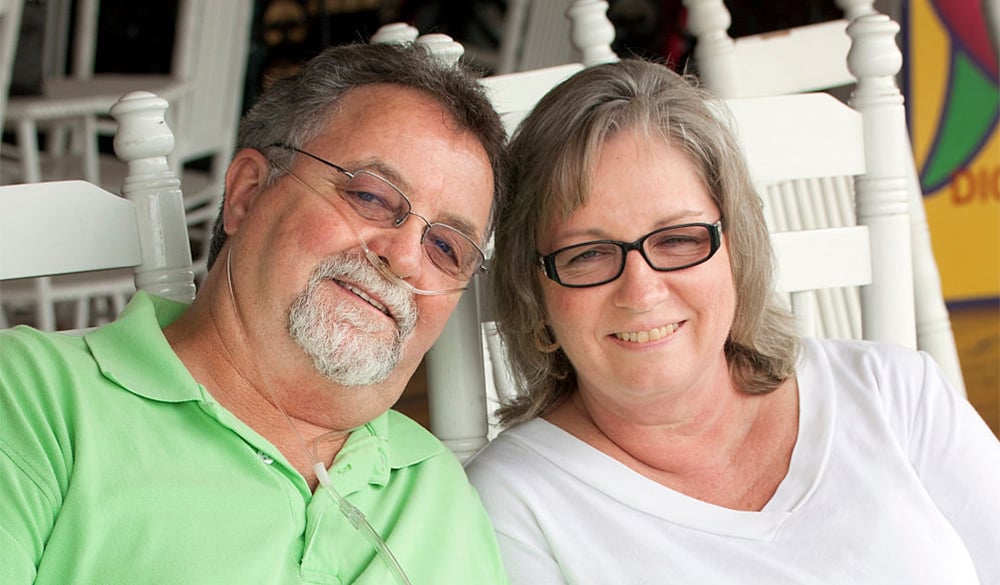The portable oxygen cylinder is a modality that permits an active oxygen user to leave the home to go shopping, to run errands, go to the doctors, to church, on vacation, etc. Activities of daily living as well as the quality of life can be greatly improved with the addition of a portable oxygen cylinder system.
A portable oxygen cylinder contains medical grade oxygen (99% or better), which is compressed into a cylinder to 2,000 p.s.i. There are special composite cylinders that can hold as much as 3,000 p.s.i.
Attached to the top of the cylinder is the regulator which reduces that 2,000 p.s.i. to a much more workable 50 p.s.i. The regulator also indicates the pressure that is remaining in the cylinder as well as controls the flow rate of the oxygen output. The flow rate is set to the prescription as ordered by the physician. The prescribed flowrate is set by turning the control knob.
The portable cylinders vary in size. The larger the cylinder, the more oxygen it will hold, and thus last longer. The size and number of cylinders provided are usually based on the patient’s daily activities and the prescription from the doctor.
The typical portable cylinder system used to be the E cylinder with a two-wheeled cart. Most portable cylinders today are made of aluminum, but in earlier years the cylinders were made of steel and weighed upwards of 30 pounds.
An E cylinder running continuously at 2 liters per minute would last approximately 5 hours. The next size smaller is the D cylinder, which would last approximately 3 hours of continuous usage at 2 liters per minute. The D cylinder would be placed in a carrying case with shoulder strap and weight upwards of 9 lbs. The smallest and lightest cylinders are used with a system called pulse dose. This system provides a burst of oxygen at the beginning of inspiration and stops flowing at the end of inspiration and exhalation, thus saving a great deal of wasted oxygen. Thus, a pulse dose system can use a much smaller and lighter cylinder to provide many more hours of oxygen allowing the oxygen user to be much more active.
While lighter and longer-lasting, a pulse dose system is not for everyone. First your doctor needs to approve of you being on a pulse dose system. Second, you must show that you can maintain a good blood saturation while on the pulse dose system. If your oxygen levels decrease while using the pulse dose, it just may not work for you.
Below is a general how-to guide for using your regulator and portable oxygen cylinder.
Attaching the regulator:
- Remove the protective tape from the cylinder valve stem.
- Open the cylinder valve slightly letting a rush of oxygen out of the cylinder. Immediately close the cylinder valve. This blows out any dust that may be in the cylinder valve outlet. Note: make sure the valve outlet is not pointed towards anyone when you perform this maneuver.
- Next, examine the regulator to verify that it has a good washer in place. If there is no washer and you open the cylinder valve, you will hear a loud rush and you will lose a large amount of oxygen. If you do not have a washer, call your supplier.
- Slide the regulator over the cylinder stem lining up the two pins in the regulator with the two holes in the cylinder valve stem. The regulator is seated properly when the two pins slip into the two holes. Hand tighten using the T bar on the regulator.
Operating the Portable Cylinder:
- Slowly open the cylinder valve (turning counterclockwise) using the oxygen wrench or toggle bar if in place. You should see the contents (pressure) gauge slowly increase. A full cylinder will be around 2,000 p.s.i. If you opened the valve and the contents needle did not move, you have an empty cylinder and need to try another one.
- Turn the flow rate to your prescribed liter flow or setting. Attach the oxygen tubing to the outlet on the regulator. Place the cannula on your face and adjust for comfort.
Turning off the Portable:
- Using the cylinder wrench or toggle bar if attached, turn the valve stem clockwise and watch the contents needle on the regulator. If you closed the valve totally, you will see the needle go down. When the needle reaches zero, turn the flow control knob to the closed position. It is now ready to be safely stored until next use.
For your safety, do not store cylinders in an enclosed space such as a closet. Cylinders that are not secured such as in a cart should be stored lying on their sides and not near any heat source.




.png?width=767&name=COPD%20in%20the%20cold%20(2).png)









